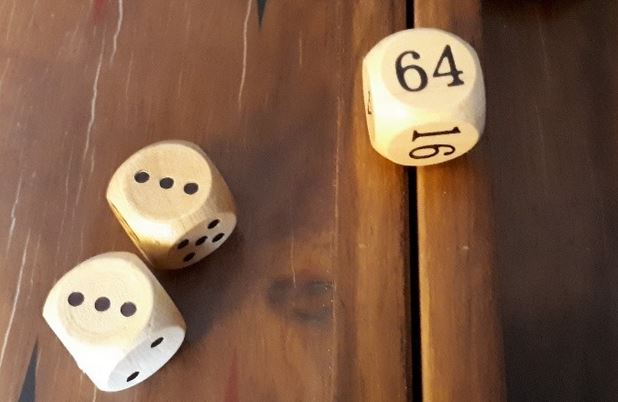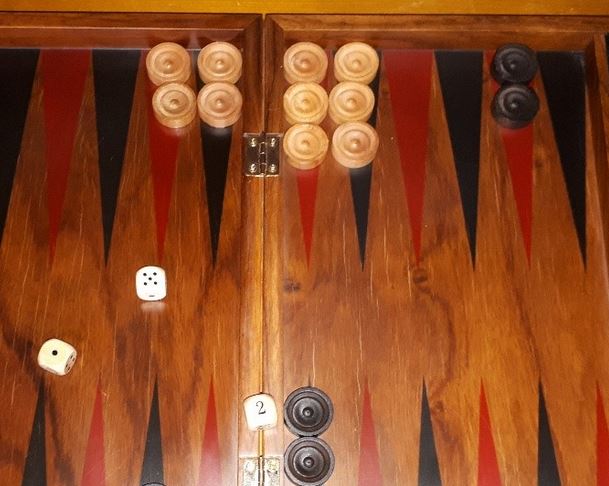Last updated on July 13, 2024
Deluxe Backgammon is a small group of UK backgammon enthusiasts that meet and play weekly in London. Typically, we will play in a local pub or café for a couple of hours in the evening after work. Depending on how many of us play on any particular evening one or more of us will bring along their best backgammon set. Every time we play, without fail, we will have some spectators stop by and pass comments. They normally reminisce about playing backgammon in their childhood and they always say how much they loved the game. We will invite them to join us for a game, but invariably they decline. They will claim that they “don’t have the time”, “need to relearn the game” or point at the doubling cube and shake their heads stating that they “have never used the cube before”.
This Deluxe Backgammon post takes a brief look at the doubling cube and explains the basic concepts. It is relatively simple and most beginners should be able to become comfortable with the doubling cube after only a handful of games.
History
Although backgammon has been played for around five thousand years, the doubling cube is a relatively new addition to the game. In the 1920s the game experienced a renaissance when an unknown player in a New York venue introduced the world of backgammon to the doubling cube. Although gambling had been part of the game for thousands of years, the concept of doubling added a completely new dimension to the game, which added to the thrill of competing at backgammon. Before the introduction of the doubling cube, backgammon was a challenging and complex game, but there were a couple of issues that inhibited its popularity against some of the other available dice games. Firstly, some games dragged on endlessly even though the result was a foregone conclusion. This resulted in long games with a tiny return for the amount of time invested. The winnings would be the same for a ten-minute game as it would be for thirty minutes or longer. Secondly, for those wishing up the ante during a game, there was no mechanism to do so. Then in the 1920s, an unknown player in New York invented doubling.
Concept
The concept behind doubling is relatively straightforward. Imagine a game where the stake is £1. Player A thinks they have an advantage over Player B and they state: ‘I think I have an advantage, therefore I wish to double the stake’. Player B then has two options, they can decline the double, pay Player A the original stake (£1) and the game ends, or they can accept the double and play on with the stake now at £2. Player B now holds the doubling cube and is the only player able to redouble. If the game subsequently turns around and Player B gains the advantage, they may now offer a re-double to Player A, which would increase the stake by £4. Player A would have the same two options of declining and paying Player B £2 or continuing the game with the stake raised to £4 and with ownership of the doubling cube.
Although the standard doubling cube has a maximum value of 64, there is no limit as to how many doubles can occur in a game. If the value were to rise above 64, the players would need to agree on how to record the doubling count.
The initial reaction of most beginners, particularly those playing a superior opponent, would be to decline the offer to double. After all, their opponent clearly considers that they have a significant advantage, so isn’t it better to decline the offer and cut their losses? In some cases, the answer is yes, but if we consider the basic mathematics behind the concept of doubling then we can disprove this theory.
Theory
Imagine that in four consecutive games, your opponent offers you a double. As the beginner in the paragraph above you decline each offer. This would mean you had lost four points and if you were gambling, probably £4. Now imagine that you had accepted the doubles and lost three games, but managed to win one. In this instance, you will have lost six points (three games at two points a game) and won two points (one game at two points) The net result is the same, you are down four points or £4. Therefore, winning one game in four at doubled stakes is the same as losing all four at the original stake. In other words, you need a 25% chance of winning, in order to accept a double.
How to calculate the chance of winning when offered a double is another dedicated post in itself. However, for a beginner, just understanding how far behind they are in the race should be enough to make a decision. If the race is close, accept, if your opponent is significantly in front decline. Pip counting helps the decision-making become a lot clearer, but a beginner should be able to get a feel for the decision after a few games.
The invention of the doubling cube solved both of the problems discussed earlier in the post. In games where one player had an overwhelming advantage, the game would end quickly with the offer of a double. This avoids the tiresome drawn-out games that have an inevitable conclusion. For those who like to gamble, the mechanism was now in place to facilitate an increase in the stakes during the game.
Related content
Backgammon rules are available on this link.
Beginners guide to the doubling cube by the Voice of Backgammon.



The doubling cube is a great addition to the game of backgammon.
Hi Marco, I know a lot of people who play backgammon socially and don’t use the doubling cube, which is totally fine if they are enjoying their backgammon. However, the doubling cube adds a new dimension to backgammon, especially when playing matches. Thanks for taking the time to comment at Deluxe Backgammon, Jason.